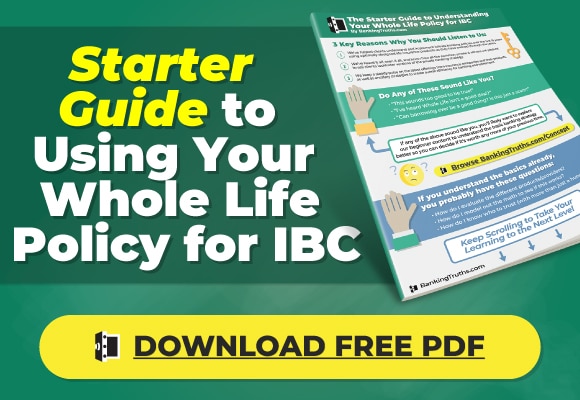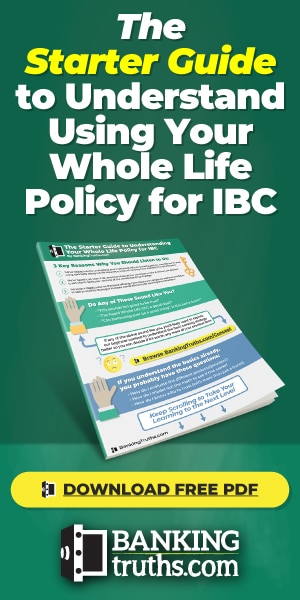Rising Interest Rates on Whole Life and Infinite Banking
Wondering how rising rates affect Whole Life dividends & cash value?
This video goes into a detailed study using historical data from an actual policy from 1980-2022. Even though dividend rates spiked up and then ebbed & flowed downward trending lower for decades, the actual dividends paid kept getting bigger and bigger. See what the 10-Pay Whole Life policy from 1980 was illustrated to yield in terms of both dividends and cash value vs. what actually happened. The results are mind-blowing and totally counter-intuitive.
Transcript Below:
I’ll bet a lot of you are wondering in today’s rising interest rate environment, does it still make sense to use whole life insurance as a long-term savings vehicle? Because it used to be that our traditional banks weren’t paying us much in the way of a savings rate.
I used to say a rate that starts with a dot. In fact, the big-name banks still aren’t paying that much. They’re a little stingy compared to the online banks which are paying upwards of three. So we’re gonna compare in this video a high-level overview of those current new higher assumptions of the savings rate compared to today’s whole life policies still in low dividend rate environments.
And we’re also gonna go back in time to see how an actual policy performed as dividend rates ebbed and flows as they rose and fell over time to see if this will be a good long-term strategy. So let’s get into it. One of the main reasons why whole life is not only still viable, but arguably more important than ever is its tax treatment.
And what you’re looking at here is from usdebtclock.org, it tracks are national debt, and you can see we’re up to $31 trillion now. That’s a crazy number, especially since I remember seeing that sign in New York City when I was out there in 2017 we’re in the low twenties, and now we’re one and a half X that.
The Top 4 Myths Behind Becoming Your Own Banker (Article)
The Simple Science Behind The Banking Concept (Video)
4 Ways Whole Life Insurance Can Help Your Retirement (Article)
Whole Life’s Riders And Growth Components Explained (Video)
Detailed Banking Case Study Using Whole Life (Video)
Best Whole Life Insurance Policy for Banking & Why (Article)
The Top 4 Myths Behind Becoming Your Own Banker (Article)
The Simple Science Behind The Banking Concept (Video)
4 Ways Whole Life Insurance Can Help Your Retirement (Article)
Whole Life’s Riders And Growth Components Explained (Video)
Detailed Banking Case Study Using Whole Life (Video)
Best Whole Life Insurance Policy for Banking & Why (Article)
Now, one of the scariest boxes on this whole matrix is the federal debt-to-GDP ratio. We’re up to 121 and what that means is, we have 121%, the amount of debt compared to how much the country’s bringing in. And if we include the states, we’re actually up to 135. Now, to put this into context I made this matrix for my followers and clients showing what we projected the debt to GDP ratio before covid.
You could see it goes to 2019. We thought it would get to 125. You’ve just seen we’re past that. And the last time we were at these levels was around World War 2. And that made sense. We had to do, go into deep, into debt to protect not only our country, but the world from Adolph Hitler. And if we looked at what happened to taxes after that is they were incredibly high because we had to bring that ratio down.
Now, if we scroll to the right and we see where we’re at now, taxes may seem very, very high to you at this moment, but you ain’t seen nothing yet. And so what you need is you need a vehicle that’s immune to taxes, and let me just show you what that could mean for your safer, your emergency fund, your opportunity fund, your liquid and safe assets that you want to keep accessible to you at all times.
Before we get into the columns and numbers and the graphs for that matter, I want you guys to know we’ve really stacked the deck on the side of the taxable account against the whole life insurance policy because if you’ve followed me for a while, you know how conservative I like to be in my assumptions.
Now, to be consistent throughout this entire study, we’re gonna use the same set of variables that were used in the actual performance study from 1980, and in it they use a stock template policy. No special term riders or PUA riders on top. Just a stock 10 pay and a 10 pay using the 1958 mortality tables.
They hadn’t updated them in 1980 and they didn’t use somebody young and healthy. They use a 50-year-old at a standard rating. Not preferred. Not preferred plus. So arguably things are a little watered down here, and even still, this policy illustrated cash on cash to project 4.02% out into the future. Now what it actually got was 5.76%, and it doesn’t, may not sound like a big difference, but that’s a massive difference compounded over time.
And again, we’re gonna look at the summary first, and then we’re gonna go year by year to see what actually happened when dividend rates rose and fell.
So with the first-year contribution of $14,445 and nine more years of about $1,200 a month, what would the total growth be after 15 years? If you got 3.3% exactly what you can get today? And a tax rate of only 33% that never went up. Well on that $144,000 you put in, you’d have about $37,000 of growth.
Now, if we put the same assumptions into a tax-exempt vehicle, like life insurance earning 4.02%, your total growth is double $75,449. Now think about it, you’ve feathered in that $14,000 you put in $144,000 over 10 years, and after 15 years, you’re about one and a half extra. Not bad. Well, short-term isn’t exactly why you’re doing this.
They call it whole life for a reason because you actually enjoy the benefits and they get better over the course of your whole life. And you’ll see that a little bit later as we go year by year. And you see those dividends just stacking and compounding on each other. But if we stretch this out to say 40 years, Well now you’ve earned $170,000 on the taxable account, and you’ve earned $444,000 at 4.02%.
Now again, that’s assuming today’s low dividend environment. And the interest rates haven’t caught up because short-term interest rates of savings accounts are a lot noisier than dividends. If you remember, I told you that the long-term study showed that it was 5.76%. Well, now you’re not at $444,000 simply by going from 4.02% to 5.76%.
That total growth went from $444,000 to $923,000. Over five X, which you’d have in the savings account. That’s some real cheddar. Keep in mind too, that this grid doesn’t even take into account that if you actually need, you want to use this money, whether it’s for an emergency, whether it’s for some kind of strategic investment opportunity, sending your kid to college using it for retirement income.
When you take from that blue account, you stop earning that 3.3%. Your compounding starts all over again versus when you borrow against the life insurance, your compounding keeps working for you. And as you pay down that lien to fatten up the goose to use more golden eggs in the future, you end up at a higher place in line every single time.
Obviously, there’s no way for us to predict what your average will actually be, but what we can do is we can go back in time and look at that old whole life policy from 1980. Obviously, past performance is no indication of future returns, but there is a lot to be gleaned by looking at certain years where dividends spiked and dividends fell and looking at the impact on not only that year’s dividend, but the actual cash value as well.
And so what you see here is the year, with the total dividends, both what was originally illustrated, where the dividend rate was static, like all illustrations, and what actually happened in those years and the impact, the cumulative impact on total cash value. Again, what was illustrated with a steady dividend rate, and what actually happened?
Needless to say, if we look at year one, it’s pretty uneventful because what was illustrated to be paid as a dividend was actually paid. That’s the year it was illustrated. But if we fast forward five years to 1985, this grid does go in five-year blocks. We can see a $2,200 dividend was illustrated to be paid.
But what actually got paid was $5,100 – more than double. And if we fast forward another five years, a $4,200 dividend was illustrated to be paid instead, it was nine thousand. Pretty big difference. Now, don’t get too excited yet because in the early years of a policy, the dividends are much less robust than later. Why is that?
It’s because you’re still feathering money in, so you shouldn’t be that concerned with what the dividend is this year, as a lot of my clients are when they’re looking at the policy. What’s the dividend rate? Well, on a $1,300 dividend, who cares, right? When it’s $4,200 growing to nine, that makes a much bigger difference after you’ve got the bulk of your premiums in.
Now, if we fast forward another five years, let’s look at the differential here. A $5,400 dividend was subjected to be paid, and instead a $12,500 dividend was paid. This is getting really, really interesting. Now, it’s also worth noting that through the 1980s dividend rates rose. They started in this policy at 8.27%.
That 1985 dividend, it was 12.2%. Then in 1990, it had dropped to 10 and a half, and by 1995, it went all the way down to 9%. Now from 1996 to 2000, the dividend rate went from 8.4% to 8.3%. 13 basis points or less from where we started. Remember we started at 8.27% – 96 to 2000 were 8.4% to 8.3%. So, what I want you to notice is that the actual should be a lot closer to illustrated if this linear dividend model that most of my clients think of came true.
But we can see in 2000, after five years of dividends almost being the exact same as what they’re illustrated, a $7,121 dividend was illustrated, and $18,000 dividend was actually paid. This is one and a half x. This is actually the biggest differential that we’ve had so far. It’s a really, really big deal.
Now, it’s also worth noting that if we look from 2002 on, the dividend rate is actually lower than where it was originally illustrated the entire time. So you would expect dividends to get a lot lower. But that is not the case. Let’s just see 2005, $9,000 dividend, $19,000 dividend paid. 2010, $10,700 dividend illustrated, $25,000 dividend paid. 2015, $12,000 dividends illustrated $33,000 dividend paid, and that’s because of the continuous compounding that happens in whole life.
Once a dividend is declared and you roll it into your policy as a paid up addition, it gets added to the guaranteed cash value, which also has to equal the death benefit. So that is going to continue to grow. Not to mention it does subject you to bigger cuts of future dividend pools, and if we look at 2020, we can see a $15,000 dividend was illustrated – a $30,000 dividend paid.
They lowered dividend rates substantially here and were still kicking butt by two x . Again, unfortunately, we can’t model higher dividend rates with current policies. The software just simply won’t let us. So hopefully this historical model helped you understand the effect of rising rates on growth.
Now, in the next episode, we are gonna explore current policies using the same assumptions and show how the rising interest rate environment does affect the policy loan rate, whether you need to use it for emergencies, opportunities, college tuition, or retirement. In fact, episode three is all gonna be about the dynamic retirement model.
So just the existence of whole life, separate and distinct from its own growth can help enhance the efficiency of all the other assets you’ve prepared for your retirement. So definitely check out those next episodes and as always, you can book an appointment using the link below. We’ll talk to you soon.

John “Hutch” Hutchinson, ChFC®, CLU®, AEP®, EA
Founder of BankingTruths.com
The Top 4 Myths Behind Becoming Your Own Banker (Article)
The Simple Science Behind The Banking Concept (Video)
4 Ways Whole Life Insurance Can Help Your Retirement (Article)
Whole Life’s Riders And Growth Components Explained (Video)
Detailed Banking Case Study Using Whole Life (Video)
Best Whole Life Insurance Policy for Banking & Why (Article)

